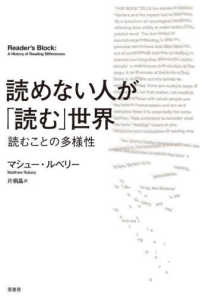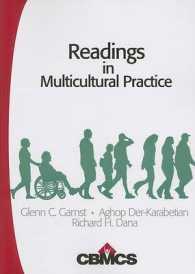- ホーム
- > 洋書
- > 英文書
- > Science / Mathematics
Full Description
Extensively revised and updated edition of the bestselling textbook, provides an overview of recent global airline industry evolution and future challenges
Examines the perspectives of the many stakeholders in the global airline industry, including airlines, airports, air traffic services, governments, labor unions, in addition to passengers
Describes how these different players have contributed to the evolution of competition in the global airline industry, and the implications for its future evolution
Includes many facets of the airline industry not covered elsewhere in any single book, for example, safety and security, labor relations and environmental impacts of aviation
Highlights recent developments such as changing airline business models, growth of emerging airlines, plans for modernizing air traffic management, and opportunities offered by new information technologies for ticket distribution
Provides detailed data on airline performance and economics updated through 2013
Contents
Notes on Contributors xiii
List of Contributors xix
Series Preface xxi
Acknowledgments xxiii
1 Introduction and Overview 1
Peter P. Belobaba
1.1 Introduction: The Global Airline Industry 1
1.1.1 Deregulation and Liberalization Worldwide 4
1.1.2 Industry Evolution Since 2000 6
1.2 Overview of Chapters 13
References 17
2 The International Institutional and Regulatory Environment 19
Amedeo R. Odoni
2.1 Introduction 19
2.2 Background on the International Regulatory Environment 20
2.2.1 The Chicago Convention 20
2.2.2 Freedoms of the Air 21
2.3 Airline Privatization and International Economic Regulation 24
2.3.1 Airline Privatization 24
2.3.2 Types and Critical Aspects of Air Service Agreements 25
2.3.3 Typical Content of Bilateral and Multilateral ASAs 26
2.3.4 The Unified EU Market and Other Major Developments 29
2.3.5 The Role of Airline Alliances 32
2.4 Airports 33
2.4.1 Restrictions on Airport Access 33
2.4.2 Airport Ownership and Management 36
2.5 Air Traffic Management 39
2.6 Key Organizations and Their Roles 41
2.6.1 International Organizations 41
2.6.2 Organizations in the United States 43
2.7 Summary and Conclusions 45
References 46
3 Overview of Airline Economics, Markets and Demand 47
Peter P. Belobaba
3.1 Airline Terminology and Definitions 47
3.1.1 Basic Airline Profit Equation 49
3.2 Air Transportation Markets 51
3.2.1 Typical Air Passenger Trip 51
3.2.2 Spatial Definitions of Airline Markets 52
3.3 Origin-Destination Market Demand 55
3.3.1 Dichotomy of Airline Demand and Supply 55
3.3.2 Factors Affecting Volume of O-D Demand 57
3.3.3 Quality of Service Factors 57
3.3.4 Total Trip Time and Frequency 58
3.4 Air Travel Demand Models 60
3.4.1 Elasticity of Air Travel Demand 60
3.4.2 Air Travel Demand Segments 62
3.4.3 O-D Market Demand Functions 64
3.5 Airline Competition and Market Share 67
3.5.1 Market Share/Frequency Share Model 67
3.5.2 "S-Curve" Model Formulation 69
3.5.3 Quality of Service Index (QSI) Models 70
3.6 Summary 71
References 72
4 Airline Pricing Theory and Practice 75
Peter P. Belobaba
4.1 Airline Prices and O-D Markets 75
4.1.1 Regulated versus Liberalized Pricing 76
4.1.2 Theoretical Pricing Strategies 77
4.1.3 Price Discrimination versus Product Differentiation 79
4.2 Differential Pricing 79
4.2.1 Market Segmentation 81
4.2.2 Fare Product Restrictions 82
4.2.3 Airline Fare Structures 83
4.3 Recent Trends in Airline Pricing 89
4.3.1 Branded Fare Families 90
4.3.2 Unbundling and Ancillary Revenues 91
4.4 Airline Pricing Strategies 93
4.4.1 Factors Affecting Fare Structure in an O-D Market 93
4.4.2 Competitive Fare Matching 96
References 98
5 Airline Revenue Management 99
Peter P. Belobaba
5.1 Computerized Revenue Management Systems 101
5.2 Flight Overbooking 103
5.3 EMSR Model for Flight Leg Revenue Optimization 108
5.4 Network Revenue Management 112
5.4.1 O-D Control Mechanisms 113
5.4.2 Network RM Optimization Models 118
5.4.3 Revenue Benefits of O-D Control 120
5.5 Revenue Management for Less Restricted Fare Structures 121
5.5.1 Demand Forecasting by Willingness to Pay 122
5.5.2 Marginal Revenue Optimization: Fare Adjustment Theory 123
References 125
6 Airline Operating Costs and Measures of Productivity 127
Peter P. Belobaba
6.1 Airline Cost Categorization 127
6.1.1 Administrative versus Functional Cost Categories 128
6.1.2 Cost Drivers by Functional Category 132
6.2 Operating Expense Comparisons 133
6.2.1 Percentage Breakdown of Operating Expenses 133
6.2.2 Aircraft Operating Cost Comparisons 134
6.2.3 Low-Cost Carriers 140
6.3 Comparisons of Airline Unit Costs 145
6.3.1 Total Operating Costs versus Unit Costs 145
6.3.2 Legacy versus Low-Cost Carrier Unit Costs 148
6.4 Measures of Airline Productivity 153
6.4.1 Aircraft Productivity 153
6.4.2 Labor Productivity 156
References 158
7 The Airline Planning Process 159
Peter P. Belobaba
7.1 Fleet Planning 160
7.1.1 Airline Fleet Decisions 161
7.1.2 Fleet Planning Methods 166
7.2 Route Planning 170
7.2.1 Hub Economics and Network Structure 170
7.2.2 Route Planning and Evaluation 175
7.3 Airline Schedule Development 180
7.3.1 Frequency Planning 181
7.3.2 Timetable Development 182
7.3.3 Fleet Assignment and Aircraft Rotations 185
7.4 The Future: Integrated Airline Planning 186
References 187
8 Airline Schedule Optimization 189
Cynthia Barnhart and Vikrant Vaze
8.1 Schedule Optimization Problems 190
8.2 Fleet Assignment 191
8.2.1 The Fleet Assignment Model 195
8.2.2 Fleet Assignment Solutions/Impacts 198
8.2.3 Extending Basic Fleet Assignment Models 198
8.3 Schedule Design Optimization 203
8.3.1 Modeling the Optimization of Flight Retiming and Fleet Assignment Problems 206
8.3.2 Importance of Modeling Competition in Schedule Design 207
8.4 Crew Scheduling 209
8.4.1 The Crew Pairing Problem 210
8.4.2 Crew Scheduling Problem Solutions and Impacts 215
8.5 Aircraft Maintenance Routing and Crew Pairing Optimization 215
8.5.1 Modeling and Solving the Extended Crew Pairing Problem 217
8.5.2 Modeling and Solving the Restricted Aircraft Maintenance Routing
Problem Based on the Solution to the Extended Crew Pairing
Problem 218
8.6 Future Directions for Schedule Optimization 219
References 221
9 Airline Flight Operations 223
Alan H. Midkiff, R. John Hansman, Jr., and Tom G. Reynolds
9.1 Introduction 223
9.2 Regulation and Scheduling 224
9.2.1 General Regulatory Requirements 224
9.2.2 Flight Crew Regulation and Training 224
9.2.3 Flight Crew Scheduling 226
9.3 Flight Crew Activities during a Typical Flight 227
9.3.1 Flight Crew Sign-In 228
9.3.2 Operations/Planning 228
9.3.3 Preflight 233
9.3.4 Predeparture 240
9.3.5 Gate Departure 242
9.3.6 Taxi-Out 243
9.3.7 Takeoff 244
9.3.8 Terminal Area Departure 245
9.3.9 Climb 246
9.3.10 Cruise 247
9.3.11 Descent 250
9.3.12 Terminal Area Arrival 253
9.3.13 Final Approach 254
9.3.14 Landing and Rollout 256
9.3.15 Taxi-In 257
9.3.16 Parking 258
9.3.17 Postflight 259
9.4 Summary 259
List of Abbreviations 260
References 262
10 Irregular Operations: Schedule Recovery and Robustness 263
Cynthia Barnhart and Vikrant Vaze
10.1 Introduction 263
10.2 Irregular Operations 264
10.2.1 Managing Irregular Operations: Airline Operations Control Centers 266
10.2.2 Options for Schedule Recovery from Irregular Operations 267
10.2.3 Schedule Recovery from Irregular Operations: Objectives and Process 269
10.2.4 Evaluating the Costs of Recovery Options: The Challenges Imparted by Uncertainty and Downstream Effects 278
10.3 Robust Airline Scheduling 279
10.3.1 Robust Schedule Design 280
10.3.2 Robust Fleet Assignment 281
10.3.3 Robust Aircraft Routing 281
10.3.4 Robust Crew Scheduling 283
10.4 Directions for Ongoing and Future Work on Schedule Recovery from Irregular Operations 284
References 285
11 Labor Relations and Human Resource Management in the Airline Industry 287
Jody Hoffer Gittell, Andrew von Nordenflycht, Thomas A. Kochan, Greg J. Bamber, and Robert B. McKersie
11.1 Alternative Strategies for the Employment Relationship 288
11.2 Labor Relations in the US Airline Industry 289
11.2.1 Regulatory Framework for US Labor Relations 291
11.2.2 US Airline Responses to Cost Pressures Postderegulation 293
11.2.3 US Labor Relations Post-September 11, 2001 299
11.3 Labor Relations in the Airline Industry in Other Countries 302
11.3.1 The International Regulatory Framework for Labor Relations 302
11.3.2 Summary of Airline Labor Relations Strategies: What Works? 310
11.4 Human Resource Management at Airlines 312
11.4.1 Hiring and Training for Relational Competence 316
11.4.2 Flexible Boundaries between Jobs 316
11.4.3 Supervisory Coaching and Feedback 317
11.4.4 Performance Measurement at the Process Level 318
11.4.5 Conflict Resolution 318
11.4.6 Boundary Spanning Roles 319
11.4.7 Partnering with Other Key Players 320
11.4.8 Leadership 321
11.5 Conclusions 322
References 323
12 Aviation Safety and Security 327
Arnold I. Barnett
12.1 Safety 328
12.1.1 Safety Is No Accident 328
12.1.2 Measuring Air Safety: Some Hazards 329
12.1.3 The Q-Statistic 331
12.1.4 Some Calculated Q-Values 332
12.1.5 Other Approaches to Safety Measurement 333
12.1.6 Are Some Airlines Safer Than Others? 334
12.1.7 The Last Century 335
12.1.8 A Collision Risk Assessment 337
12.1.9 Midair Collision Risk 340
12.2 Security 341
12.2.1 September 11 in Context 341
12.2.2 Some Costs of Aviation Security 342
12.2.3 Some Security Procedures 343
12.2.4 Is It Worth It? 349
12.2.5 Two Economic Paradigms 349
12.2.6 A European Dilemma 351
12.2.7 More Security Dilemmas 353
12.2.8 Final Remarks 358
References 359
13 Airports 361
Amedeo R. Odoni
13.1 Introduction 361
13.2 General Background 363
13.3 Physical Characteristics 366
13.3.1 Airside Design Standards 366
13.3.2 Geometric Configuration on Airside 369
13.3.3 Typology of Passenger Buildings 372
13.3.4 Assessing Passenger Building Concepts 374
13.3.5 Ground Access 376
13.4 Capacity, Delays, and Demand Management 377
13.4.1 Airside Capacity 377
13.4.2 Airside Delays and Their Mitigation 379
13.4.3 Landside Capacity and Level of Service 381
13.5 Institutional, Organizational, and Economic Characteristics 384
13.5.1 Airport Ownership and Management 384
13.5.2 Airport User Charges 385
13.5.3 Economic Regulation 389
13.5.4 Financing Capital Projects 391
References 392
14 Air Traffic Control 395
R. John Hansman, Jr. and Amedeo Odoni
14.1 Introduction 395
14.2 The Generic Elements of an ATC System 396
14.2.1 Communications Systems 397
14.2.2 Navigation Systems 397
14.2.3 Surveillance Systems 402
14.2.4 Flight and Weather Information Systems 404
14.3 Airspace and ATC Structure 405
14.4 ATC Operations 408
14.5 Standard Operating Procedures 410
14.6 Capacity Constraints 411
14.7 Congestion and Air Traffic Flow Management 417
14.8 Future ATC Systems 420
References 420
15 Air Transport and the Environment 423
Karen Marais, Philip J. Wolfe, and Ian A. Waitz
15.1 Introduction 423
15.2 Limiting Aviation's Environmental Impact: The Role of Regulatory Bodies 425
15.3 Airport Water Quality Control 426
15.3.1 Effects of Deicing Fluids 428
15.3.2 Managing Airport Water Quality 429
15.4 Noise 430
15.4.1 Effects 432
15.4.2 Noise Measurement 433
15.4.3 Noise Trends 435
15.4.4 Noise Controls 436
15.4.5 Emerging Issues 438
15.5 Air Quality 439
15.5.1 Effects 442
15.5.2 Emissions Measurement 443
15.5.3 Emissions Trends 443
15.5.4 Emissions Control 447
15.5.5 Emerging Issues 448
15.6 Impact of Aviation on Climate 449
15.6.1 Effects 449
15.6.2 Measurement 451
15.6.3 Greenhouse Emissions Control 452
15.7 Alternative Fuels 453
15.8 Summary and Looking Forward 455
References 456
16 Information Technology in Airline Operations, Distribution and Passenger Processing 461
Peter P. Belobaba, Cynthia Barnhart, and William S. Swelbar
16.1 Information Technology in Airline Planning and Operations 461
16.2 Airline Distribution Systems 464
16.2.1 Evolution of Computer Reservations Systems 464
16.2.2 Alternative Airline Distribution Channels 469
16.3 Distribution Costs and e-Commerce Developments 475
16.3.1 Internet Distribution Channels 477
16.3.2 Electronic Ticketing 481
16.3.3 Implications for Airlines and Consumers 481
16.4 Innovations in Passenger Processing 482
References 485
17 Critical Issues and Prospects for the Global Airline Industry 487
Peter P. Belobaba, William S. Swelbar, and Amedeo R. Odoni
17.1 Evolution of US and Global Airline Markets 488
17.1.1 Evolution of US Airline Markets 488
17.1.2 Recent Developments in Global Airline Markets 491
17.2 Looking Ahead: Critical Challenges for the Global Airline Industry 494
17.2.1 Strategies for Sustained Profitability 495
17.2.2 Infrastructure and the Environment 498
References 500
Index 501







